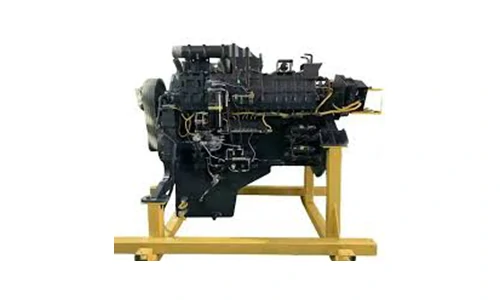At all speeds, the exhaust pipe of the Komatsu engine emits a rhythmic “thump” sound, which is caused by the failure of a few cylinders. When diagnosing this fault, the “thump” sound of the exhaust pipe is more obvious at a speed slightly higher than the idle speed, and it is also easier to distinguish by slow acceleration.
First check whether the high-voltage distribution line has fallen off and whether it is inserted into the jack next to the distributor cover according to the ignition sequence. If no abnormality is found after checking, the tip of the unscrew cone can be used to touch the end cover when the engine is idling, and the middle of the unscrew cone can be close to the top of the spark plug of a cylinder to short-circuit the spark plug of the cylinder. If the engine speed changes, it means that the cylinder is working well. If the engine speed does not change, it means that the cylinder is not working.

One cylinder is not working
Remove the high-voltage wire of the cylinder and keep the wire end about 5mm away from the spark plug to check whether it sparks.
(1) No sparking
If there is no sparking, the fault is in the distributor, the plug next to the distributor cover or the cam angle. The diagnosis and troubleshooting methods are as follows:
① Pull one end of the distributor slightly out of the plug next to the distributor cover to check whether the plug next to the distributor sparks toward the distributor. If it sparks toward the distributor, it is leakage. If there is no sparking, turn off the engine and check whether there are sand holes, cracks or other leakage points in the plug next to the distributor cover. If there is no leakage point, it is uneven wear on the edges and corners of the cam.
② Turn the crankshaft to check whether each cam angle can push open the distributor contact. If any cam angle cannot push open the contact, it means that the cam is too worn and the cam should be replaced.
(2) Sparking
If there is sparking and the engine speed becomes uniform, it means that the spark plug of the cylinder has too much carbon deposits or the porcelain core has slight leakage. If there is sparking but the engine speed does not change, it means that the spark plug has serious leakage or there is no electrode gap.
Two cylinders do not work
Remove the high-voltage branch wires of the two cylinders respectively, about 5mm away from the spark plug, and check whether there is sparking. If both cylinders spark and the engine speed does not change, the spark plugs of the two cylinders do not work; if both cylinders do not spark, the fault should be eliminated according to the method of one cylinder not working and the high-voltage branch wire not sparking. When it is found that the high-voltage branch wire of one cylinder has fire and the high-voltage branch wire of the other cylinder has no fire, it should be eliminated according to the method of one cylinder not working, the high-voltage branch wire has fire or no fire.
The diagnostic method is as follows: When the spark plugs of each cylinder are short-circuited with a cone, if it is found that the two adjacent cylinders in the ignition sequence do not work, first remove the high-voltage branch wire of the next cylinder, 5mm away from the spark plug (not on the cylinder body), and check the sparking situation. If there is no spark or the spark is weak, reinstall it; then remove the other high-voltage branch wire and use the above method to check the sparking situation.
If there is no spark or the spark is weak, remove the high-voltage branch wire that was originally checked and leave it suspended. At this time, the high-voltage distribution line that was checked later suddenly had a strong spark (it was still 5mm away from the spark plug), and the engine speed increased slightly. The fault was leakage in the socket next to the distributor cover.


